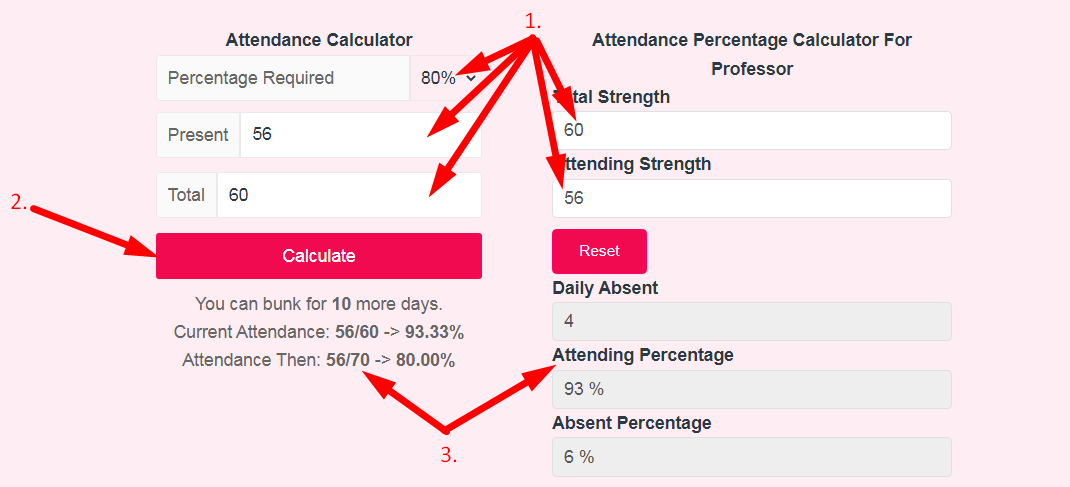Attendance Calculator
Attendance Percentage Calculator for College. Find out the number of days you should attend to attain 80% attendance or the number of days you can bunk if you have more than 80%
Absent Days Attending Percentage Absent Percentage
Average Rating: Tool Views: 321
How to use this Attendance Calculator Tool?
The Attendance Calculator is a useful tool for businesses, schools, and organizations to track the attendance and working hours of employees or students. This article will explore the features and benefits of an Attendance Calculator, how it works, and why it is important for effective time management and payroll processes.
What Is an Attendance Calculator?
An Attendance Calculator is a software tool or application that helps organizations track the attendance and working hours of their employees or students. It allows employers or administrators to record the time when individuals check in and out of work or classes and calculate the total number of hours worked or attended. Some Attendance Calculators also provide additional features, such as generating reports, managing overtime, and integrating with payroll systems.
How Does an Attendance Calculator Work?
An Attendance Calculator typically works in the following way:
- Check-In and Check-Out: Individuals check in and out of work or classes by scanning a QR code, using a mobile app, or entering their details into a digital form.
- Time Tracking: The Attendance Calculator records the time when individuals check in and out, as well as any breaks or lunch periods taken.
- Calculation: The Calculator automatically calculates the total number of hours worked or attended based on the check-in and check-out times.
- Reporting: Some Attendance Calculators generate reports that can be used for payroll processing, compliance, and other purposes.
Benefits of an Attendance Calculator
There are several benefits to using an Attendance Calculator:
-
Accurate Time Tracking: An Attendance Calculator provides accurate and reliable time tracking, reducing errors and discrepancies in attendance records.
-
Efficient Payroll Processing: By automating the calculation of working hours, an Attendance Calculator streamlines payroll processing, saving time and reducing administrative costs.
-
Compliance and Legal Requirements: An Attendance Calculator helps organizations comply with labor laws and regulations by accurately recording working hours and providing documentation for audits and inspections.
-
Employee Accountability: An Attendance Calculator encourages employees to be punctual and accountable for their time, as their attendance is accurately tracked and recorded.
-
Improved Productivity: By monitoring attendance and working hours, an Attendance Calculator can help identify trends and patterns that may impact productivity, enabling organizations to make informed decisions and adjustments.
-
Integration and Scalability: Many Attendance Calculators can be integrated with other systems, such as payroll and HR software, and are scalable to accommodate the needs of growing organizations.
How to use Yttags's Attendance Calculator?
- Step 1: Select the Tool

- Step 2: Enter The Following Options And Check Your Attendance Calculator Result

How to calculate attendance percentage?
FormulaNumber of Members Absent Daily = Total Strength – Attendance Strength
| Attending Percentage | = | Attendance Strength Total Strength | x 100 |
Absent Percentage =100 – Attending Percentage
Example:
A class contains 80 students. On a day, the attendance strength of the class was 70. Find the daily attendance percentage.
👉 Solution:Number of Members Absent Daily = 80 – 70 = 10 Attending Percentage = (70 / 80) x 100 = 87.50% Absent Percentage = 100 – 80 = 12.50%
Attendance Percentage: 87.50% Daily Absent Count: 10 Absent Percentage: 12.50%
Conclusion
In today's fast-paced and dynamic work and educational environments, effective time management and attendance tracking are essential for success. An Attendance Calculator is a valuable tool that helps organizations manage their time and attendance effectively, leading to improved productivity, compliance, and employee satisfaction. Whether it's for a small business, a large corporation, or an educational institution, an Attendance Calculator is a reliable and efficient solution for tracking time and attendance.
